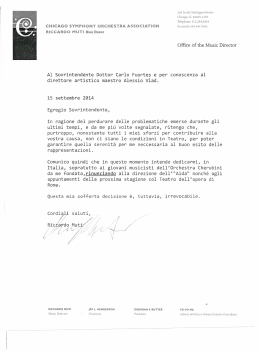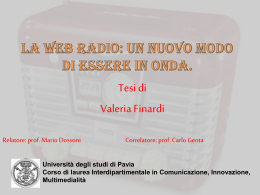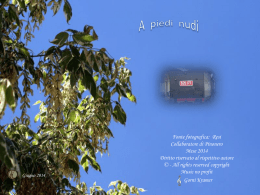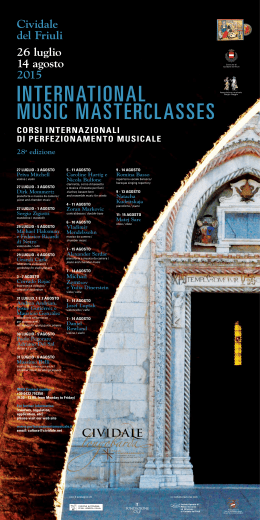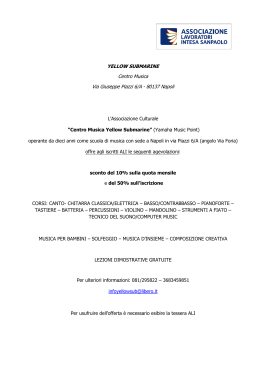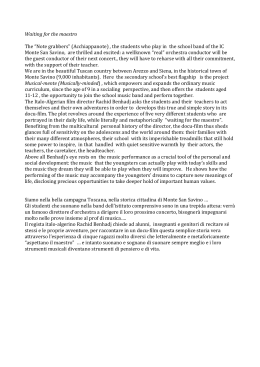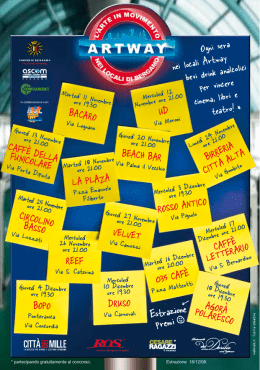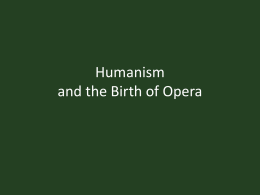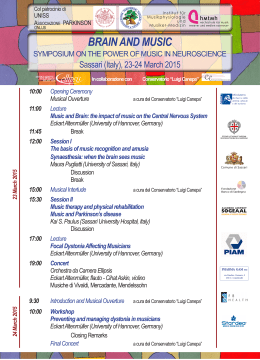1 Ms Burton; Thank you for the proposal of Italian Theoretical Treatises. We are indeed very interested in this area as you may know from our HARMONOLOGIA: STUDIES IN MUSIC THEORY series which contains a number of treatises on theory by Fétis and Reicha. We could happily enfold your series within HARMONOLOGIA, General Editor David Damschoder, if this would suit your expectations. Can you send us a list of the proposed treatises and, if possible, the names of the proposed translators? That would be most helpful. This sounds like an exciting project and we hope we can be involved with it and with you. _____________________________________ Bob Kessler Managing Editor Pendragon Press (518) 325-6100 From: Deborah Burton [mailto:[email protected]] Sent: Sunday, December 11, 2011 8:51 PM To: [email protected] Cc: Giorgio Sanguinetti Subject: proposal for new series ©Deborah Burton, 2004 2 10 December 2011 Claire Brook, Executive Editor, Pendragon Press P.O. Box 190 Hillsdale, NY 12529 USA / email: [email protected] Dear Ms. Brook, We are very pleased to be sending you the enclosed proposal for a new series entitled Italian Theoretical Treatises. Now is the right time for English translations of Italian music theory: the year 2012 will see the publication of an annotated translation of Francesco Galeazzi’s 1796 Elementi Teorico-pratici di Musica from the University of Illinois, and Giorgio Sanguinetti’s The Art of Partimento: History, Theory and Practice from Oxford University Press. Recent successful publications that deal directly with Italian theoretical traditions include Robert Gjerdingen’s Music in the Galant Style (Oxford) and Nicholas Baragwanath’s The Italian Traditions and Puccini: Compositional Theory and Practice in Nineteenth-Century Opera (Indiana). Until recently, anglophone music theoretical studies recognized few Italian sources: the Cambridge History of Western Music Theory mentions only a handful, while exploring in depth the analytic work of numerous northern Europeans. But this is changing: the adoption of partimenti studies in many conservatories and music departments will require access in English to the works of Fenaroli, Valente, etc., and will spark greater interest in other Italian authors such as Martini and Asioli. At the same time, Yale’s Music Theory Translation Series is no longer active, and Thomas Mathiesen’s translation series at the University of Illinois (Studies in the History of Music Theory and Literature) has published its last volume. Thank you very much for considering publishing these valuable books, which we are offering exclusively to Pendragon. We look forward to hearing from you as soon as possible. Best regards, Deborah Burton tel: 978-448-0643 / cell: 978-621-3084 home: 258 Main Street, Groton, MA 01450 email: [email protected] Giorgio Sanguinetti tel: +39-06-32.11.02.65 home: via Giuseppe Avezzana, 6, 00195 Roma, Italy email: [email protected] ©Deborah Burton, 2004 3 NEW SERIES: ITALIAN THEORETICAL TREATISES EDITORS: DEBORAH BURTON (BOSTON UNIVERSITY) AND GIORGIO SANGUINETTI (UNIVERSITY OF ROME-TOR VERGATA) I. Description of series Until very recently, anglophone music theoretical studies recognized few Italian sources: the Cambridge History of Western Music Theory mentions only a handful, while exploring in depth the analytic work of numerous northern Europeans. But this is changing: the adoption of partimenti studies in many conservatories and music departments requires access (with contextual and practical explications) in English to the works of Fenaroli, Valente, etc., and is sparking greater interest in other Italian authors such as Martini and Asioli. At the same time, Yale’s Music Theory Translation Series is no longer active, and Thomas Mathiesen’s series at the University of Illinois (Studies in the History of Music Theory and Literature) has published its last volume. We envision an initial publication of three volumes—Padre Martini’s 1775 Esemplare (vol. 2), Fedele Fenaroli’s c. 1800 Regole, and Bonifazio Asioli’s 1836 Il maestro di composizione—translated into English and fully annotated for the modern reader, to be completed within five years. Martini’s Esemplare is described below. Fenaroli, a contemporary of Haydn, studied with the Francesco Durante in Naples and became one of the co-directors of the combined conservatories of Naples in the early nineteenth century. Published editions of his partimenti remained in print until the early twentieth century, and his work was foundational for many that came after. (Although his partimenti and regole are available now online, our proposed volume would also supply much-needed explanatory commentary in English.) Asioli, composer, theorist and performer, was the first director of the conservatory in Milan; his treatise Il Maestro di composizione consists of three parts, plus examples—“Harmony,” “Counterpoint,” and “Composition.” It was published posthumously, and offers examples from operas composed at the time of Rossini, Bellini, and Donizetti. We hope that, after these initial three volumes, the series might continue with annotated English translations of Pier Francesco Tosi’s Opinioni de' cantori, Saverio Valente’s Manoscritti di partimenti (unpublished), and the first volume of Francesco Galeazzi’s Elementi Teorico-pratici di Musica (1791). With a distinguished press like Pendragon, these books would quickly become staples of music libraries around the world. II. Description of Martini’s Esemplare Tout le contrepoint italien est aujourd'hui renfermé dans la tête d'un moine franciscain. Il faut que les maîtres lui aillent baiser la sandale pour avoir de la musique, comme on va baiser la mule du Pape pour avoir des indulgences. Ange Goudar, 17771 Padre Martini, the teacher whom Mozart called the “one person in the world whom I love, revere and esteem most of all,” turned away from his work on the epic Storia della Musica in order to write his Esemplare. There was a need, he confided to his student Giuseppe Paolucci, to create a manual out of the notes and examples he used in his teaching. Martini's two-volume Esemplare (1774, 1775) is now chiefly known to anglophones through Alfred Mann's The Study of Fugue. This partial English translation is accompanied by an essay that leaves the strong impression that Martini's work contains no didactic laying-out of contrapuntal rules, a conclusion abetted by the work's title of “exemplar.” Mann goes so far as to write, “Martini's role is that of the mentor who establishes a standard for the student through example” and that the work is to be “understood as a 'graduate course' intended for the student who has completed his apprenticeship in counterpoint and fugue.” In fact, in the prefaces to both volumes of his work, Martini sets out very specific rules, beginning at the most elementary level. For example, the preface to the first volume, subtitled Saggio fondamentale pratico di contrappunto sopra il canto fermo, includes a “Brief Compendium of the Elements and Rules of Counterpoint,” which begins by defining intervals, consonance versus 1 Jean-Jacques Sonnette [pseud. Ange Goudar], Le brigandage de la musique italienne n.p. 1777: 99-100. ©Deborah Burton, 2004 4 dissonance, etc.--hardly a graduate course. In the second volume, on contrappunto fugato, the anthology procedes in order of voices, from two to eight, each type illustrated by several examples, while the preface gives clear rules for writing canons and fugues, and definitions of fugal terminology, with explanatory musical examples. An English translation of this preface has already been published as Deborah Burton, “Padre Martini's Preface to his Esemplare, Part II: an original, annotated translation” Theoria, vol.11 (2004): 35-108, and is included with this proposal in a separate attachment. • apparatus A book of this type has a great many musical examples. There are seventy-three in the second volume alone, and some are quite extensive. In compensation, however, there is comparatively little written. III. Outline of the annotated translation of Padre Martini’s Esemplare, volume II. Table of Contents I. Introduction: this would describe Martini’s life, cultural milieu, historical context and influence on a generation of composers, including J.C. Bach and Mozart. II. Preface IIL. Fugue for Two Voices IV. Fugue for Three Voices V. Fugue for Four Voices VI. Fugue for Five Voices VII. Fugue for Six Voices VIII. Fugue for Seven Voices IX. Fugue for Eight Voices IV. Status of the annotated translation of Padre Martini’s Esemplare, volume II The preface to volume II of Martini’s Esemplare has already been completed and published. The remaining text is not extensive: transcribing the numerous musical examples and annotating these for the modern scholar would require the most attention. An estimated date for completion is January 2013. After this is completed, work would begin on the Fenaroli volume and then the Asioli. The annotated translations of the three volumes should be finished in five years. V. Series editors [curriculum vitae included below] ©Deborah Burton, 2004 5 DEBORAH BURTON CURRICULUM VITAE ADDRESS: 258 Main Street, Groton, MA 01450 TELEPHONE: 978-448-0643 EMAIL: [email protected] CELL: 978-621-3084 RECENT AND FORTHCOMING PUBLICATIONS BOOKS • Burton, Deborah. Recondite Harmony: The operas of Puccini. An analytically based exploration of Puccini’s musical techniques and how they developed throughout his entire oeuvre. [forthcoming.] • Burton, Deborah and Gregory Harwood. “Francesco Galeazzi, Theoretical-Practical Elements of Music: An Annotated Translation and Introduction, Studies in the History of Music Theory and Literature, vol. 5 (Urbana: University of Illinois Press, under contract with the University of Illinois Press). [Italian treatise, placed in its intellectual context, which discusses music history, basic theoretical elements, counterpoint, sonata form and 18th-century compositional techniques.] This book has been awarded a subvention grant from the Society for Music Theory (2011). • Burton, Deborah, Susan Vandiver Nicassio and Agostino Ziino. Tosca's Prism: Three Moments of Western Cultural History, Boston: Northeastern University Press, 2004. Co-editor and contributor. [an interdisciplinary symposium on three diverse moments of European history through the prism of Puccini's opera Tosca: the events of the story took place in June 1800; the Puccini opera premièred in 1900; and the year 2000 serves as the present.] This book was awarded a subvention grant from the American Musicological Society (2004). JURIED JOURNAL ARTICLES • “Ariadne’s Threads: Puccini and Cinema,” accepted for publication in Studi Musicali (2012). • “Guida e Conseguente: Padre Martini and Galeazzi on Fugue,” Rivista di Analisi e Teoria Musicale (RATM), 2011. [places Galeazzi's observations in the context of his mentor's work, with original translations of both texts, written in classic dialogue format.] • “Padre Martini's Preface to his Esemplare, Part II: an original, annotated translation” Theoria, v.11, 2004. [The partial translations of the works of Padre Martini, counterpoint teacher of Mozart, Johann Christian Bach, Cherubini and others, have omitted his preface, leaving a false impression that the great scholar left no counterpoint treatise; this article corrects that error and provides the complete translation.] • “Orfeo, Osmin and Otello: Towards a Theory of Opera Analysis,” Studi Musicali, 2004/2: 359-385. [three diverse operatic selections are discussed in light of a new aproach to opera analysis.] • “A Journey of Discovery: Puccini’s 'motivo di prima intenzione' and its applications in Manon Lescaut, La Fanciulla del West and Suor Angelica,” Studi Musicali, 2001/2: 473-499. ©Deborah Burton, 2004 6 • “Possibili fonti storiche per la Tosca,” Nuova Rivista Musicale Italiana, 4/2 (April/June 2000): 199220. REVIEWS, BOOK CHAPTERS AND NON-JURIED ARTICLES • Review of Puccini’s Late Style by Andrew Davis, and The Italian Traditions and Puccini: Compositional Theory & Practice in Nineteenth-Century Opera (2011) by Nicholas Baragwanath for Music Theory Spectrum, 2012. • Review of The Music of Our Lives by Kathleen Higgins, for The Review of Metaphysics, forthcoming. • Review of Mozart on the Stage by John A. Rice, Notes, (June 2010), n.p. • “Men Who Love Too Much: Operatic Heroes and the Metric and Tonal Disturbances that Follow them.” to be published in Schenker Studies IV, ed. Lynne Rodgers and Poundie Burstein. (New York: Olms, forthcoming). • Review of Reading Opera Between the Lines: Orchestral interludes and cultural meaning from Wagner to Christopher Morris, Music Theory Spectrum, 2008. Berg by • Review of Mozart and His Operas by David Cairns, Notes, (December 2007): 266-269. • Review of Heinrich Schenker: A Guide to Research by Benjamin Ayotte, Music Reference Services Quarterly, 2005. • “Tosca Act II and the Secret Identity of F#” in Deborah Burton, Susan Vandiver Nicassio and Agostino Ziino. Tosca's Prism: Three Moments of Western Cultural History (Boston: Northeastern University Press, 2004: 147-166. • Review of Tosca's Rome by Susan V. Nicassio, Notes (March 2000): 647-648. • “Tristano, Tosca e Torchi,” In Studi Musicali Toscani: Giacomo Puccini: L'uomo, il musicista, il panorama europeo, Gabriella Biagi Ravenni and Carolyn Gianturco, eds. Lucca: Libreria Musicale Italiana, 1997: 127-145. • “The Creation of Tosca: towards a clearer view,” Opera Quarterly 12/3 (Spring, 1996): 27-34. • “Michele Puccini's Counterpoint Treatise” Quaderni pucciniani (1996): 173-181. • “Select Bibliography,” In The Puccini Companion, William Weaver and Simonetta Puccini, eds. New York: Norton, 1994: 327-334. • “The Real Scarpia: Historical Sources for Tosca,” Opera Quarterly, 10/2 (Winter 1993-94): 67-86. ACADEMIC APPOINTMENTS • 2006- Boston University, School of Music, Assistant Professor of Music Theory. Undergraduate: coordinator of Aural Skills Program, chromatic harmony, form, opera history, tonal counterpoint. Graduate: form and analysis, Schenkerian analysis, graduate theory review. Reappointed April 2008. ©Deborah Burton, 2004 7 • 2004-2006: Florida International University, Assistant Professor. Undergraduate: diatonic and chromatic harmony, counterpoint, aural skills. Graduate: form and analysis, counterpoint, Schenkerian and post-tonal analysis, graduate theory review. • 2003-2004: University of Massachusetts, Amherst, Visiting Assistant Professor. Undergraduate: chromatic harmony, form and analysis; Graduate: seminar in Analysis 1600-1750, seminar in Analysis 1825-1900. • Fall 2003: Harvard University, Lecturer on Music, tonal counterpoint. • 2002-2003: Harvard University, Visiting Scholar research appointment. • 2001-2002: Fordham University, Visiting Assistant Professor of Music. Undergraduate: tonal counterpoint, diatonic harmony, intro to music history, introduction to opera, Baroque music history. • Spring 2000: Harvard University, Lecturer on Music. Undergraduate: tonal counterpoint, replacing David Lewin. • 1996-2001: Harvard University. Undergraduate: Teaching assistant in music theory and Head Teaching Fellow and Teaching Assistant in the Core Program (Thomas F. Kelly's First Nights: Five Performance Premieres and Lewis Lockwood's Opera: Perspectives in Music and Drama). • 1990-1996: [doctoral research for theory dissertation in Italy and Switzerland] • 1986-1990: Adrian College, Adrian, Michigan. Instructor, Music Faculty. Undergraduate: music theory (including 20th C. techniques), music history survey, studio piano. • 1988-1989: University of Michigan, Ann Arbor, Michigan, Teaching assistant. Undergraduate: Music theory and aural skills. • 1985-1986: University of Michigan, Teaching assistant. Studio piano. • 1983-1985: Yale School of Music, Teaching assistant. Studio piano. MUSICAL EDUCATION • 1987-1996: Ph.D., University of Michigan, Ann Arbor, Michigan, Music Theory. Doctoral dissertation: “An Analysis of Puccini's Tosca: a heuristic approach to the unifying elements of the opera.” Unanimously nominated for the university's Distinguished Dissertation Award and winner of the one-term dissertation fellowship. • June 2001: Mannes Summer Institute in Historical Music Theory, New York City, participant in seminars on Ancient Greek Music Theory (with Thomas Mathiesen) and Early 18thCentury Music Theory (with Joel Lester). • 1986-1987: D.M.A. Program (incomplete), University of Michigan, Ann Arbor, Michigan, in piano, with Theodore Lettvin. ©Deborah Burton, 2004 8 • 1983-1985: M.M., Yale School of Music, New Haven, Connecticut, solo piano. • 1979-1983: Diploma, The Mannes College of Music, New York, solo piano. PAPERS AND PRESENTATIONS • Sept. 2011 Presenter and session chair, VII European Music Analysis Conference, Rome, Italy. Topic: “Ariadne’s threads.” • May 2011 Invited speaker, “Puccini e Lucca nel Mondo” sponsored by the Dante Alighieri Society, The Boston Chapter of the Associazione Lucchesi nel Mondo and the Fondazione Giacomo Puccini. • April 2011 Invited speaker, interdisciplinary conference, Pride, Envy, Greed: from Cain to Present. James Madison University, Harrisonburg, Va. Topic: “Tosca’s Fatal Flaw.” • April 2011 Keynote presenter, “Approaches to Opera Analysis,” plenary panel discussion, New England Conference of Music Theorists, Brandeis University, with William Rothstein (CUNY), Peter Westergaard (Princeton), and Matthew Shaftel (Florida State). • Dec. 2010 Organizer and speaker, organizer and speaker at symposium Fanciulla 100: Celebrating Puccini, co-hosted by the Howard Gotlieb Archival Center and the College of Fine Arts. Topic: “The Rhythms of Fanciulla.” • Dec. 2010 Organizer and chair, round-table discussion entitled “La Fanciulla del West: a Century of Puccini's Girl of the Golden West” Italian Cultural Institute, New York. Speakers included: Allan Atlas (CUNY), Marcello Giordani (tenor, Met Opera), Nicola Luisotti (conductor, Met Opera), Harvey Sachs (Curtis Institute of Music), Walfredo Toscanini (grandson of conductor Arturo Toscanini), Simonetta Puccini (granddaughter of composer Giacomo Puccini), Sarah Billinghurst (Met Opera), Francesco Maria Talò (Consul General of Italy) and Riccardo Viale (Director, Italian Cultural Institute in New York.) • Oct. 2010 Invited speaker, “The Twists and Trysts of Tosca” Boston Lyric Opera at the Boston Public Library. • Nov. 2010 Round-table discussion with John Conklin on Puccini’s Tosca, BU Opera Institute. • April 2010: Guest lecturer, Hartt Music Theory Forum, Hartt School of Music, Topic: “Mozart and Musical Mad Men.” • March, 2010: Guest lecturer, Boston University Alumni Association, Topic: “Action Fragmented: Silent-Film Techniques and the Music of Puccini.” • Jan. 2010: Guest lecturer, Lindemann Young Artist Development Program, The Metropolitan Opera. Topic: Opera analysis. • June 2009: Guest lecturer, University of Rome - Tor Vergata. Topic: Opera analysis. • Nov. 2008: Presenter, American Musicological Society and Society for Music Theory Joint Annual Meeting, Nashville, TN. Paper title: “Puccini and Early Film.” ©Deborah Burton, 2004 9 • Nov. 2008: Panelist, American Musicological Society and Society for Music Theory Joint Annual Meeting, Nashville, TN. Panel title: “Puccini the Modernist?” • April 2008: Organizer and presenter, interdisciplinary conference “Opera and Society,” Boston University. Paper title: “In his shoes: the Marriage of Figaro and the Movies.” Podcast on www.operaandsociety.org. • Nov. 2007: Session chair, Scholars for Social Responsibility, at the annual meeting of the Society for Music Theory, Baltimore, MD. Special session on academic freedom. • April 2007: Boston University Musicology Colloquium: “Staging Bohème: The Practice of History” panel discussion with Alessandra Campana (Tufts), Deborah Burton (BU) and Sharon Daniels (BU). • Nov. 2006: Session chair, “Opera” session, Society for Music Theory Annual Meeting, Los Angeles, CA. • Nov. 2006: Session co-chair, Scholars for Social Responsibility, at the annual meeting of the Society for Music Theory, Los Angeles, CA. • March 2006: Presenter, Fourth International Schenker Symposium, Mannes College of Music, New York City, Paper title: “Men who love too much: Operatic Heroes and the Metric and Tonal Disturbances that Follow them.” [discussion of arias by Mozart's Cherubino, Handel's Orlando and Puccini's Jack Rance in which metric and tonal anomalies mirror emotional states.] • April 2005: Presenter, New England Conference of Music Theorists, Amherst, MA. Topic: “Guida e Conseguente: Padre Martini and Francesco Galeazzi on Fugue” [comparison of the near contemporaries' writings on fugue presented as a masterstudent dialogue.] • March 2005: Guest lecturer, University of Connecticut-Storrs. Topic: “The Naked Pitch-class and Musical Fan Dancing.” [the seemingly anomalous use of a single pitch class in extremely tense operatic moments, thus contrasting with the usual associations of consonant unisons and octaves with “rest” and “resolution” with three examples, from La Bohème, Salome and Wozzeck. An explanation is proposed relating to the Freudian concepts of primary and secondary process thinking.] • March 2004: Music Theory Lecture Series University of Massachusetts. Topic: “The Shawshank Redemption, The Marriage of Figaro and Trading Places” [the uses of music from Figaro in the two films are related to the Enlightenment social message of equality and musico-dramatic structure of the opera.] • June 2000: Originator, co-organizer, presenter and fundraiser for international, interdisciplinary bilingual conference, Tosca 2000, Teatro dell’Opera, Rome, Italy. Held in honor of the centennial of Puccini’s Tosca and the bicentennial of the historical events on which it was based. Topic: “Tosca Act II and the secret identity of F#” [large-scale motivic expansions in Act II and their relationship to the dramatic structure and to the overal design of the opera.] • Oct. 1997: Presenter, New England Chapter, AMS, “Scenes Unseen from La Bohème.” ©Deborah Burton, 2004 10 [libretto drafts] • Feb. 1996: Session chair and presenter, “Puccini, youth to maturity: from Edgar to La bohème,” Teatro Regio, Turin and the Istituto di Studi Pucciniani, Milan. Topic: “Prime versioni del libretto de La bohème alla Casa Giacosa.” • Nov. 1995: 18th annual annual meeting of the Society for Music Theory, New York City. Topic: “Remote regions and Puccini's motivic territory.” [motivic expansions and surface manipulations in three Puccini operas] • Nov. 1994: Presenter, 17th annual meeting of the Society for Music Theory, Tallahassee, Florida. Topic: “Il segreto della forma di Giacomo Puccini.” [first SMT presentation on Puccini: motivic expansions, Wagnerian connections and development of new operatic analytic techniques] • Nov. 1994: “Convegno internationale di studi su Puccini nel 70o anniversario della morte,” Lucca, Italy. Topic: “Tristano, Tosca. e Torchi.” [large-scale structural design of Tosca.] ONLINE ACTIVITIES • 2010-2011 www.fanciulla100.org, organizer. In celebration of the centennial of Puccini’s La Fanciulla del West, at the Metropolitan Opera in December 1910, this educational website, linked to the Met’s site, will include video interviews of performers and specialists, videos of Puccini and old New York, a virtual museum, articles, archival images, and streaming of Fanciulla videos. • 2008- www.operaandsociety.org, organizer. Podcasts of Boston University’s interdisciplinary conference. Paper title: “In his shoes: the Marriage of Figaro and the Movies.” These podcasts are currently being duplicated in the BU Digital Common. SERVICE TO PROFESSION • 2010-2011 Member, Nominating Committee, Society for Music Theory (national) • April 2011: Co-leader, Student Workshop on Opera Analysis, New England Conference of Music Theorists, Brandeis University, with William Rothstein (CUNY). • 2009- Member of the Editorial Board of the Rivista di Analisi e Teoria Musicale (RATM), journal of the Gruppo di Analisi e Teoria Musicale (GATM), based in Italy. • 2007-2009: President, New England Conference of Music Theorists. Instituted the NECMT prize (an essay contest for scholars of all ranks), the NECMT student workshops (three-hour sessions with distinguished scholars of the field, open to students of any rank), podcasts of presentations, and online voting. • 2009-10: Chair, Mentoring Program, SMT Committee on Professional Development. (national) • 2006- Co-chair, Scholars for Social Responsibility, Society for Music Theory Interest Group. (national) ©Deborah Burton, 2004 11 • 2007-2009: SMT Mentoring Program, mentoring young theory and musicology graduate students. • 2007-2009: Member, Committee on Professional Development, Society for Music Theory. (national) • 2006-2007: Member, Committee on the Status of Women, Society for Music Theory. (national) •2006-2007: Program committee member, New England Conference of Music Theorists. • 2006-2007: Member at Large, Music Theory Southeast. • 2006: Session Chair, “Opera,” Society of Music Theorists, national meeting, Los Angeles • 2005-2006: Program committee member, Music Theory Southeast annual meeting, University of North Carolina, Chapel Hill, March 3-4, 2006. • 2005-2006: Representative of School of Music Curriculum Committee to the College of Arts and Sciences Curriculum Committee, Florida International University, Miami, FL. • 2005: Session chair: Interdisciplinary Approaches, Music Theory Southeast annual meeting, University of Miami, Miami, FL. • 2000-2004: Secretary, New England Conference of Music Theorists. • 2003-2004: Music Theory Committee, University of Massachusetts, Amherst. • Mar. 1999: Session chair and program committee member, New England Conference of Music Theorists, Harvard University. • 1996- Member, Istituto di Studi Pucciniani, Milan, Italy. GRANTS AND AWARDS • 2011 Society for Music Theory, Subvention grant, for Burton, Deborah and Gregory Harwood. “Francesco Galeazzi, Theoretical-Practical Elements of Music: An Annotated Translation and Introduction, Studies in the History of Music Theory and Literature, vol. 5 (Urbana: University of Illinois Press, under contract with the University of Illinois Press). • 2010-2011 Humanities Enhancement Project Grant, Humanities Foundation, Boston University ($10,000), for Fanciulla 100, a project celebrating the centennial of Puccini’s opera La fanciulla del West. • 2009-2010: Junior Fellowship, Humanities Foundation, Boston University, one-term sabbatical for Fall 2009 for work on the manuscript Recondite Harmony: the Music of Puccini. • June 2009: Visiting Scholar, American Academy in Rome. • 2008: Humanities Foundation Award, Boston University, for conference Opera and ©Deborah Burton, 2004 12 Society. • 2004-2005: Fulbright Scholar Program, to Italy, Alternate. • Jan/June 2004: Visiting Scholar, American Academy in Rome. • 2004: American Musicological Society Subvention Grant for book Tosca's Prism. • 2002-2003: Harvard University, Visiting Scholar research appointment. • 1995: Unanimously nominated for Distinguished Dissertation Award, University of Michigan. • 1994: One-term Dissertation Fellowship, University of Michigan. • 1989: Block grant, University of Michigan. OTHER PROFESSIONAL ACTIVITIES • Oct. 2010: Pre-concert lecturer, Boston Lyric Opera. • May 2009: Pi Kappa Lambda, member Alpha Kappa chapter at Boston University. • 1999-2007: Pre-concert lecturer, New York City Opera. • 2004: Pre-concert lecturer, Springfield Symphony, Springfield, Massachusetts. • 2003: Guest lecturer in music, University of Massachusetts-Amherst. • 1998-2001: Guest lecturer, Harvard University, in Lewis Lockwood's course, Opera: Perspectives in Music and Drama. • Spring 1997: Pre-concert lecturer, Boston Lyric Opera. ADDITIONAL STUDIES • June 2001: Mannes Summer Institute in Historical Music Theory, New York City, participant in seminars on Ancient Greek Music Theory (with Thomas Mathiesen) and Early 18th-Century Music Theory (with Joel Lester). • 1996-2001: Derek Bok Center, Harvard University, college-level pedagogical training. • 1985: Yale School of Music, conducting with Otto-Werner Mueller. • 1982: Aspen Music Festival, harpsichord studies, accompanying fellowship. • 1978: Accademia Chigiana, Siena, Italy, solo piano master class with Guido Agosti. ©Deborah Burton, 2004 13 • 1978: Conservatorio di Musica “S. Cecilia,” Rome, Italy, organ studies. • 1976: A.B., Barnard College, Columbia University, English Literature LANGUAGES • fluent Italian, French, reading ability in German. ©Deborah Burton, 2004 14 GIORGIO SANGUINETTI CURRICULUM VITAE address: via Giuseppe Avezzana, 6 00195 Rome, Italy telephone: +39-06-32.11.02.65 email: [email protected] Giorgio Sanguinetti received an undergraduate degree in Piano Performance from the Milan Conservatory “G. Verdi” and another in Composition from the Pesaro Conservatory in 1993. He studied Schenkerian analysis privately in New York with Carl Schachter in 1994. Beginning in 1979, he was active as a concert pianist and piano teacher. From 1994 to 2003 he taught music theory at the University of Cosenza, and, from 1996 to 1998, Post-tonal theory and Schenkerian analysis at the Conservatory of Milan. In November 2003 he was appointed Associate Professor for Music Theory at the University of Rome-Tor Vergata. He has written scholarly articles and essays in two main fields: analysis and history of music theory, often crossing the boundaries between the two disciplines, and focusing primarily on Italian music from the eighteenth to the early twentieth century. In the field of Schenkerian analysis, his most notable contributions are analyses of Bellini’s “Casta Diva” from Norma and of the second duet in Verdi’s Don Carlos, the latter published in the volume Essays from the Third International Schenker Symposium. He has also explored formal issues in an essay on recapitulations in Clementi’s piano sonatas. Prof. Sanguinetti’s research in the history of music theory, has focused on Italian music theory after the eighteenth century, a field that was almost completely neglected until recently. With two essays and a bibliography published in the 1990s, [where? title? ] he called attention to a previously unrecognized body of studies on new tonal systems written by early twentieth-century Italian musicians and theorists, including the first known description of the octatonic scale. Subsequently, he focused on the nineteenth century, and especially the theories of Abramo Basevi and the late phase of the Neapolitan school of composition. His monograph, The Art of Partimento: History, Theory and Practice, will be published by Oxford University Press in 2012. Giorgio Sanguinetti has given numerous workshops, seminars and guest lectures in many Conservatories and Universities in Italy, and has presented papers in many conferences in Europe and in the United States, in Italian, English and German. He has been a Visiting Professor at Queens College and the Graduate Center of the City University of New York, Guest Professor at the Orpheus Institute in Ghent (Belgium), and at the Schola Cantorum Basilensis (Basel, Switzerland); and a fellow of the Mannes Institute for Advances Studies in Music Theory (New York). In winter 2012 he will teach a semester at the McGill University in Montreal. ©Deborah Burton, 2004 15 Professor Sanguinetti is on the Advisory Board for the project Monuments of Partimenti, based at Northwestern University, and is a member of the editorial boards of GATM (Gruppo analisi e teoria musicale), of the journal “Analitica”, and of the publisher Fogli Volanti: for this last, he edited the Italian translation of the Aldwell and Schachter textbook Harmony and Voice Leading. In 2011 he was the president of the organizing committee of the VII European Music Analysis Conference (Euromac) in Rome. SELECTED PUBLICATIONS I. Books • Giorgio Sanguinetti, The Art of Partimento: History, Theory, and Practice. New York: Oxford University Press, 2012. • Thomas Christensen, Robert Gjerdingen, Giorgio Sanguinetti e Rudolf Lutz, Partimento and Continuo Playing in Theory and Practice (ed. D. Moelants), Leuven: Leuven University Press 2010. • Giorgio Santuinetti, Intersezioni. Quattro studi di teoria e analisi musicale (Cosenza: University of Calabria, 1999). • Edward Aldwell and Carl Schachter, Armonia e condotta delle voci. Italian edition. Giorgio Sanguinetti, ed. (Subiaco: Fogli Volanti, 2008). II. Book chapters • “Condotta delle voci ‘parsimoniosa’ e sistemi esatonali in alcuni madrigali di Gesualdo,” in Con-Scientia Musica. Contrappunti per Rossana Dalmonte e Mario Baroni. Eds. Anna Rita Addessi, Ignazio Macchiarella, Massimo Privitera, Marco Russo. Lucca: LIM 2010, pp. 223-241. • “Partimento – Fugue: the Neapolitan Angle,” in Partimento and continuo playing in theory and in practice. Dirk Moelants (ed.) Collected writings of the Orpheus Institute. vol. 9. (Leuven: Leuven University Press, 2010), pp. 71-111. • “La formazione dei musicisti italiani (1900-1950),” in La cultura dei musicisti italiani nel ‘900, Guido Salvetti and Maria Grazia Sità, eds. Musica nel Novecento italiano, 2 (Milano: Guerini, 2004), pp. 15-54. • “Casta diva o la soavità delle dissonanze,” in Et facciam dolçi canti...” Studi in onore di Agostino Ziino in occasione del suo 65° compleanno. Bianca Maria Antolini, Teresa M. Gialdroni, Annunziato Pugliese, eds. (Lucca: Libreria Musicale Italiana 2003), pp. 1133-1148. • “Exordium: La prima sinfonia,” in Van Beethoven. Le sinfonie e i concerti per pianoforte. Annalisa Bini and Roberto Grisley, eds. (Roma-Milano: Accademia Nazionale di Santa Cecilia-Skira Editore, 2001), pp. 35-49. • “La vera analisi delle melodie: la teoria ‘meloarmonica’ di Abramo Basevi,” in “Una piacente estate di San Martino.” Studi e ricerche per Marcello Conati, Marco Capra, ed. Quaderni di Musica/Realtà, Supplemento 1 (Lucca: Libreria Musicale Italiana, 2000), pp. 261-285. III. Conference Proceedings • “Il Gradus as Parnassum di Fedele Fenaroli,” in Fedele Fenaroli il didatta e il compositore. Atti del convegno nazionale Lanciano, 15-16 novembre 2008, a cura di Gianfranco Miscia. Lucca: LIM 2011, pp. 209-224. ©Deborah Burton, 2004 16 • “L’eredità di Fenaroli nell’Ottocento,” in Martucci e la “caduta delle Alpi” Atti dei convegno (Capua-Napoli 12 dicembre 2006). Antonio Caroccia, Paolo Giovanni Maione e Francesca Seller, eds. (Lucca: LIM, 2008), pp. 11-34. • “Diminution and Harmony-oriented Counterpoint in Late Eighteenth Century Naples: Vincenzo Lavigna’s Studies with Fedele Fenaroli,” in Schenkerian Analysis – Analyse nach Heinrich Schenker. Bericht über den internationalen Schenker-Kongreß in Berlin, Sauen und Mannheim, 4. – 12. Juni 2004. 1. Auflage, eds. Oliver Schwab-Felisch, Michael Polth, and Hartmut Fladt. Hildesheim: Olms, forthcoming. • “Mozart, il pianista e il teatro dei segni,” in Interpretare Mozart. Convegno internazionale di studi Milano, Castello Sforzesco 19-21 maggio 2006. Mariateresa Dellaborra, Guido Salvetti, Claudio Toscani, eds. (Lucca: Libreria Musicale Editrice, 2007), pp. 3-20. • “Dramatic Functions of ‘Tonal Field’: The Second Duet Carlos-Élisabeth in Verdi’s Don Carlos,” in Essays from the Third International Schenker Symposium, ed. Allen Cadwallader (Hildesheim: Georg Olms Verlag, 2006), pp. 81102. • “Le ‘riprese disgiunte’ nelle sonate per pianoforte solo di Muzio Clementi,” in Muzio Clementi compositore, (forte)pianista, editore. Atti del convegno internazionale di studi Perugia, Conservatorio di Musica 4-6 ottobre 2002, Bianca Maria Antolini and Costantino Mastroprimiano, eds. (Lucca: LIM, 2006), pp. 65-123. • “Puccini’s music in the theoretical italian literature of its day,” in Tosca’s Prism. Three Moments of Western Cultural History, Deborah Burton, Susan Vandiver Nicassio, and Agostino Ziino, eds. (Boston: Northeastern University Press, 2004), pp. 221-245. IV. Journal articles • “La scala come modello per la composizione.” Rivista di analisi e teoria musicale, 2009/1: 66-94. • “The realization of a partimento: an introduction,” Journal of Music Theory 51/1 (Spring 2007): 51-83. • “Decline and Fall of the «Celeste Impero»: the Theory of Composition in Naples During the Ottocento,” Studi Musicali 34/2 (2005): 451-502. • “Modi di organizzazione octatonica in La Follia di Orlando di Goffredo Petrassi,” Nuova Rivista Musicale Italiana 39/4 (2005): 491-503. • “Riconsiderando Harmonielehre,” Rivista di analisi e teoria musicale 3/2 (2004): 131-148. • “Analisi e variazioni di tempo: la Polacca op. 53 di Chopin,” Quaderni di Analitica 1 (2001): 75-98. • “Un secolo di teoria della musica in Italia. Bibliografia critica (1850-1950),” Fonti musicali italiane, 2 (1997): 155248. • “L’opera italiana nella critica musicale di Heinrich Schenker,” Nuova Rivista Musicale Italiana, 29/3 (1995): 431467. • “L’armonia modernissima. La ricerca teorica nell’Italia del primo Novecento,” Rivista Italiana di Musicologia, 30 (1995): 171-211. • “Il primo studio teorico sulle scale octatoniche: le ‘scale ‘alternate’ di Vito Frazzi,” Studi musicali, 22 (1993): 411-446. ©Deborah Burton, 2004 17 V. Reviews • Felix Salzer and Carl Schachter, Contrappunto e composizione, Italian edition. M. Baroni e E. Modena, eds. (Turin: EdT 1991) (“I Manuali EdT/SIdM”, 8), Rivista Italiana di Musicologia, 30 (1995): 326-331. • Nicholas Cook, Guida all'analisi musicale, Nuova Rivista Musicale Italiana, 27 (1993): 104-108. • Susan Kagan, Archduke Rudolph, Beethoven's Patron, Pupil and Friend - His Life and Music, Nuova Rivista Musicale Italiana, 26 (1992): 577-579. • John Waterhouse, Malipiero, Nuova Rivista Musicale Italiana, 26 (1992): 302-305. • Walter Piston, Trattato d'armonia, Nuova Rivista Musicale Italiana, 25 (1991): 294-297. • Diether de La Motte, Manuale di armonia, Nuova Rivista Musicale Italiana, 24 (1990): 223-225. VI. Multimedia • “La partizione octatonica come principio formale nel primo movimento della Sonatina (1916) di Alfredo Casella,” in Musiche del 900 italiano (cd-rom + cd-audio) (Milan: Stradivarius, 2004). ©Deborah Burton, 2004
Scarica
